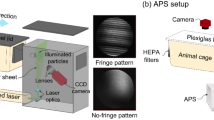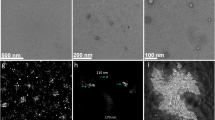Abstract
Liddell and Wootten1 have described a method for sampling fog droplets in a suitable form for measurement under the microscope. In this, microscope slides were coated with a gelatin film which incorporated a purified dye. When water droplets impinged on this film a characteristic dark crater-like ring remained after evaporation of the droplet. The film gave a permanent sample and when ideally prepared detected fog droplets down to 1µ. The ratio of the diameter of the ring to the original droplet was constant.
This is a preview of subscription content, access via your institution
Access options
Subscribe to this journal
Receive 51 print issues and online access
$199.00 per year
only $3.90 per issue
Buy this article
- Purchase on Springer Link
- Instant access to full article PDF
Prices may be subject to local taxes which are calculated during checkout
Similar content being viewed by others
References
Liddell, H. F., and Wootten, N. W., Quart. J. Roy. Meteor. Soc., 83, 263 (1957).
May, K. R., J. Sci. Instr., 27, 128 (1950).
Author information
Authors and Affiliations
Rights and permissions
About this article
Cite this article
MAY, K. Detecting Volatile Airborne Droplets. Nature 183, 742–743 (1959). https://doi.org/10.1038/183742a0
Issue Date:
DOI: https://doi.org/10.1038/183742a0
This article is cited by
Comments
By submitting a comment you agree to abide by our Terms and Community Guidelines. If you find something abusive or that does not comply with our terms or guidelines please flag it as inappropriate.



